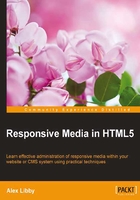
What this book covers
Chapter 1, Working with Responsive Images, starts our journey with responsive media, where we take a look at working with responsive media. We'll cover the basics with a look at a wide variety of topics, including retina images, providing fallback support, different image formats to use, and catering to the differences between mobile and desktop platforms.
Chapter 2, Adding Responsive Video Content, continues on from where we left off in Chapter 1, Working with Responsive Images, with a look at adding responsive video to our sites. We'll cover the different formats available to us and the methods to be used to determine which one to use, how to determine the size of the video to use depending on viewport space, providing fallback support, and making allowances for different platforms.
Chapter 3, Mixing Content, helps us bring it all together with a look at some of the considerations or pitfalls of mixing responsive content and how we can reduce delays by using preloaders to control when content is loaded and rendered on screen. We'll work through an example of mixing both responsive images and video on the same page, so we can see how it works in practice and consider what allowances may need to be made for different platforms.
Chapter 4, Testing Responsive Media, delves into the world of testing our creations to ensure they work properly. We'll see that there is no need for complicated tools as most of our work can be done in a browser; we will also cover some tips to troubleshoot slow performance issues and how we can make quick and easy changes to help improve speed.
Chapter 5, Using Frameworks, finishes up the book with a look at three real-world examples of using responsive media in popular frameworks; our examples include a look at WordPress, Less CSS, and Bootstrap. We'll take a look at some of the tips and tricks (and plugins) available for use in WordPress, adding responsive media to a Bootstrap-enabled webpage, and how we can use Less CSS to help better manage our CSS styles.